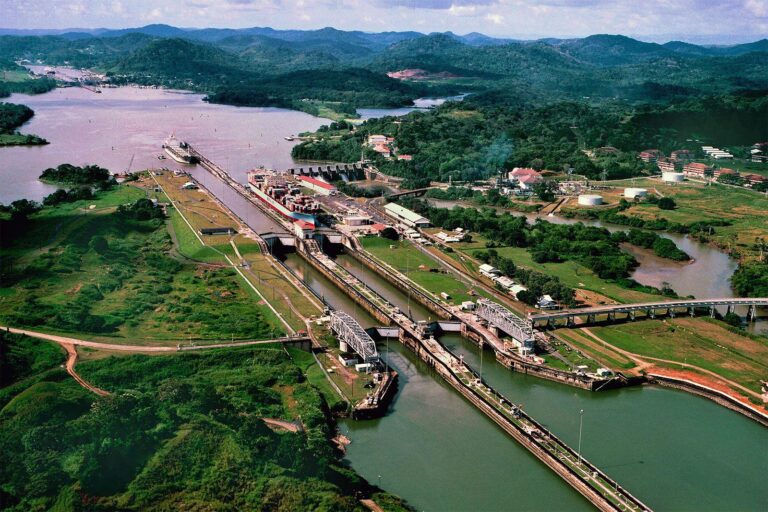The Panama Canal, a critical maritime passage connecting the Atlantic and Pacific Oceans, has long been a symbol of engineering prowess and geopolitical significance. Its history, marked by ambitious construction, international diplomacy, and strategic control, reflects the shifting tides of global influence. Recently, the canal has reemerged in political discourse as former President Donald Trump has made controversial statements threatening to retake control of this vital waterway. This article explores the historical context of the Panama Canal and examines the implications of TrumpŌĆÖs provocative stance on its sovereignty.
The Historical Significance of the Panama Canal in Global Trade
The Panama Canal stands as one of the most extraordinary engineering feats of the 20th century, drastically reshaping global trade routes by linking the Atlantic and Pacific Oceans. Before its completion in 1914, ships had to endure the perilous and lengthy journey around South America’s Cape Horn, adding weeks to shipping times. The canal slashed transit times and costs, becoming a critical artery for international commerce and military strategy alike. Its control ensured dominant influence over maritime trade flows, underscoring why the canal’s sovereignty and management have long been central geopolitical concerns.
Throughout the 20th century, ownership and operational control of the Panama Canal symbolized broader power dynamics between global superpowers. The U.S. initially wielded exclusive control, which was subsequently transferred to Panama in 1999 under the Torrijos-Carter Treaties, sparking a new era of Panamanian stewardship. Key trade statistics illustrate the canalŌĆÖs ongoing impact:
| Year | Vessels Transited | Cargo Tonnage (millions) |
|---|---|---|
| 1920 | 2,188 | 6 |
| 1980 | 13,000 | 160 |
| 2023 | 14,000+ | 230 |
The canal’s strategic importance is further highlighted by its role in supporting:
- Energy exports such as liquefied natural gas and petroleum.
- Global supply chains that depend on timely delivery of goods.
- Naval mobility during international conflicts and peacekeeping missions.
The Transfer of Canal Control from the United States to Panama
After nearly a century of American oversight, the Panama Canal’s administration was officially handed over to Panama on December 31, 1999. This pivotal transfer was the result of the Torrijos-Carter Treaties, signed in 1977 by U.S. President Jimmy Carter and Panamanian leader Omar Torrijos. The agreement aimed to respect Panamanian sovereignty while ensuring the canal’s neutrality and operational efficiency. The canal, a critical artery for global maritime trade, symbolized both American engineering prowess and geopolitical influence in the 20th century. Following the handover, Panama established the Panama Canal Authority (ACP), an autonomous agency charged with managing, maintaining, and expanding the canal to meet future demands.
- Key terms of the transfer: Full control by Panama, guaranteed neutrality of the waterway, and peaceful relations between the two countries.
- Strategic importance: The canal shortens maritime routes, enabling faster cargo transport between the Atlantic and Pacific Oceans.
- Economic impact: Panama assumed full revenue from canal operations, substantially boosting its economy.
| Year | Event | Significance |
|---|---|---|
| 1977 | Torrijos-Carter Treaties Signed | Laid foundation for canal handover |
| 1999 | Official Canal Transfer | Marked Panamanian sovereignty |
| 2006 | Canal Expansion Project Announced | Increased capacity for larger ships |
Examining Trumps Claims and Geopolitical Motivations
Former President Donald TrumpŌĆÖs recent declarations about retaking control of the Panama Canal have stirred significant geopolitical debate. His claims revolve around reasserting American dominance in a crucial maritime chokepoint, asserting that the original U.S. control safeguarded strategic and economic interests more effectively. However, critics argue that this rhetoric overlooks the complex history and agreements established following the 1977 Torrijos-Carter Treaties, which gradually transferred canal ownership to Panama by the end of 1999.
Geopolitically, the Canal serves as a linchpin in global commerce, making it a focal point for influence among superpowers and regional actors alike. Trump’s stance appears to reflect broader ambitions of reinforcing U.S. leverage in Latin America and countering growing Chinese presence in the region. Observers note the following tactical motivations embedded in his declarations:
- Reassertion of Military Presence: Control over the canal could provide the U.S. Navy with enhanced operational flexibility.
- Economic Leverage: Command of this maritime gateway facilitates control over international trade routes.
- Political Signaling: A message directed both at domestic constituents and global rivals regarding American resolve.
| Stakeholder | Interest | Current Status |
|---|---|---|
| United States | Strategic control and military mobility | No official control since 1999 |
| Panama | Sovereignty and economic revenue | Full ownership and operation of canal |
| China | Investment and influence in Latin America | Increasing presence through trade and infrastructure |
Implications for International Relations and Strategic Recommendations
The ongoing discourse surrounding the Panama Canal underscores its vital role as a geopolitical linchpin connecting the Atlantic and Pacific Oceans. TrumpŌĆÖs rhetoric about retaking control reflects deeper tensions involving sovereignty, global commerce, and military strategy. Such a move could unsettle established alliances and provoke diplomatic friction, particularly with Latin American nations. The canal remains a crucial artery for over 5% of the worldŌĆÖs maritime trade, making its administration a sensitive matter for international stakeholders who view it as a shared resource rather than a national prize.
To navigate these complexities, strategic recommendations emphasize a balanced approach that respects Panamanian sovereignty while safeguarding international interests. Key measures include:
- Enhancing multilateral dialogue through forums involving the U.S., Panama, and global trade partners
- Investing in joint infrastructural and security initiatives to assure uninterrupted operations
- Promoting transparency and equitable access policies to prevent monopolization or unilateral control
- Leveraging diplomatic channels to de-escalate rhetoric and reinforce cooperative frameworks
| Stakeholder | Primary Concern | Strategic Interest |
|---|---|---|
| Panama | Sovereignty over Canal | Economic control and national pride |
| United States | Security and Trade Stability | Maintaining influence and naval mobility |
| Global Trade Partners | Fair Access and Efficiency | Ensuring seamless global supply chains |
Closing Remarks
The history of the Panama Canal is a story of engineering marvel, geopolitical maneuvering, and enduring strategic significance. Since its completion in 1914 and the eventual transfer of control to Panama in 1999, the canal has remained a critical juncture for global trade. Recent political rhetoric suggesting a U.S. move to retake control has reignited debates about sovereignty, international law, and regional stability. As discussions continue, the future of this vital waterway will depend on careful diplomacy and a clear understanding of its complex legacy.







